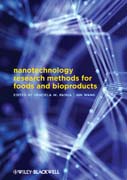
Nanotechnology research methods for food and bioproducts
Padua, Graciela Wild
Wang, Qin
Food nanotechnology is an expanding field. This expansion is based on the advent of new technologies for nanostructure characterization, visualization, andconstruction. Nanotechnology Research Methods for Food and Bioproducts introduces the reader to a selection of the most widely used techniques in food and bioproducts nanotechnology. This book focuses on state-of-the-art equipment and contains a description of the essential tool kit of a nanotechnologist. Targeted at researchers and product development teams, this book serves as a quickreference and a guide in the selection of nanotechnology experimental research tools. INDICE: Foreword xiContributors xiii1 Introduction 1Graciela W. PaduaReferences 32 Material components for nanostructures 5Graciela W. Padua and PanaddaNonthanum2.1 Introduction 52.2 Self-assembly 62.3 Proteins and peptides 82.3.1 Amyloidogenic proteins 82.3.2 Collagen 92.3.3 Gelatin 92.3.4 Caseins 102.3.5Wheat gluten 102.3.6 Zein 102.3.7 Eggshell membranes 102.3.8 Bovine serum albumin 112.3.9 Enzymes 112.4 Carbohydrates 112.4.1 Cyclodextrins 112.4.2 Cellulose whiskers 122.5 Protein-polysaccharides 132.6 Liquid crystals 142.7 Inorganic materials 14References 153 Self-assembled nanostructures 19Qin Wang and BoceZhang3.1 Introduction 193.2 Self-assembly 203.2.1 Introduction 203.2.2 Micelles 203.2.3 Fibers 213.2.4 Tubes 233.3 Layer-by-layer assembly 243.3.1 Introduction 243.3.2 Nanofilms on planar surfaces from LbL 253.3.3 Nanocoatings from LbL 273.3.4 Hollow nanocapsules from LbL 283.4 Nanoemulsions 293.4.1 Introduction 293.4.2 High-energy nanoemulsification methods 303.4.3 Low-energy nanoemulsification methods 313.4.4 Nanoparticles generated from different nanoemulsionsand their applications 33References 344 Nanocomposites 41Graciela W. Padua, Panadda Nonthanum and Amit Arora4.1 Introduction 414.2 Polymer nanocomposites 424.3 Nanocomposite formation 434.4 Structure characterization 444.5 Biobased nanocomposites 454.5.1 Starch nanocomposites 464.5.2 Pectin nanocomposites 464.5.3 Cellulose nanocomposites 474.5.4 Polylactic acid nanocomposites 474.5.5 Protein nanocomposites 484.6 Conclusion 50References 505 Nanotechnology-enabled delivery systems for food functionalization and fortification 55Rashmi Tiwari and Paul Takhistov5.1 Introduction: functional foods 555.2 Food matrix and food micro-structure 565.3 Target compounds: nutraceuticals 585.3.1 Solubility and bioavailability of nutraceuticals 605.3.2 Interaction of nutraceuticals withfood matrix 615.4 Delivery systems 645.4.1 Overcoming biological barriers 645.4.2 Nano-scale delivery systems 655.4.3 Types/design principles 675.4.4 Modesof action 695.5 Examples of nanoscale delivery systems for food functionalization 725.5.1 Liposomes 725.5.2 Nano-cochleates 745.5.3 Hydrogels-based nanoparticles 755.5.4 Micellar systems 755.5.5 Dendrimers 775.5.6 Polymeric nanoparticles 785.5.7 Nanoemulsions 805.5.8 Lipid nanoparticles 815.5.9 Nanocrystallineparticles 835.6 Conclusions 85References 856 Scanning electron microscopy 103Yi Wang and Vania Petrova6.1 Background 1036.1.1 Introduction to the scanning electron microscope 1036.1.2 Why electrons? 1046.1.3 Electron-target interaction 1046.1.4 Secondary electrons (SEs) 1056.1.5 Backscattered electrons (BSEs) 1066.1.6 Characteristic X-rays 1076.1.7 Overview of the SEM 1076.1.8 Electron sources 1086.1.9 Lenses and apertures 1096.1.10 Electron beam scanning 1096.1.11 Lens aberrations 1106.1.12 Vacuum 1116.1.13 Conductive coatings 1116.1.14 Environmental SEMs (ESEMs) 1116.2 Applications 1116.2.1 Zein microstructures 1126.2.2 Controlled magnifications 1156.2.3 Nanoparticles 1176.3 Limitations 1196.3.1 Radiation damage 1206.3.2 Contamination 1226.3.3 Charging 124References 1267 Transmission electron microscopy 127Changhui Lei7.1 Background 1277.2 Instrumentations and applications 1287.2.1 Interactions between incident beam andspecimen 1297.2.2 Conventional TEM 1307.2.3 Scanning TEM 1367.2.4 Analytical electron microscopy 1397.3 Sample preparations 1427.4 Limitations 143References 1438 Dynamic light scattering 145Leilei Yin8.1 The principle of dynamic light scattering 1458.2 Photon correlation spectroscopy 1518.3 DLS apparatus 1528.4 DLS data analysis 1568.4.1 Multiple-decay methods 1588.4.2 Regularization methods 1588.4.3 Maximum-entropy method 1598.4.4 Cumulant method 159References 1609 X-ray diffraction 163Yi Wang and Phillip H. Geil9.1 Background 1639.1.1 Introduction 1639.1.2 Classical X-ray setup 1659.1.3 X-ray sources 1659.1.4 X-ray detectors 1689.1.5 Wide-angle X-ray scattering and small-angle X-ray scattering 1699.2 Applications 1699.2.1 Example: X-ray characterization of zein-fattyacid films 1709.2.2 Temperature-controlled WAXS 176References 17910 Quartz crystal microbalance with dissipation 181Boce Zhang and Qin Wang10.1 Background and principles 18110.2 Instrumentation and data analysis 18310.2.1 Sensors 18310.2.2 Data analysis 18410.3 Applications 18510.4 Advantages 190References 19211 Focused ion beams 195Yi Wang11.1 Background 19511.1.1 Introduction to the focused ion beam system 19511.1.2 Overview of the FIB 19611.1.3 Ion beam production 19611.1.4 Ion-target interaction 19811.1.5 Basic functions of the FIB system 19911.1.6 SEM and SIM 20011.1.7 SEM and FIB combined system 20111.1.8 3D nanotomography with application of real-time imaging during FIB milling 20111.1.9 3D nanostructure fabrication by FIB 20211.2 Applications 20211.2.1 Polymers20211.2.2 Biological products 20311.2.3 Example: self-assembled protein structures 20311.3 Limitations 207References 21412 X-ray computerized microtomography 215Leilei Yin12.1 Introduction 21512.2 X-ray generation 21512.3 X-ray images 21712.4 X-ray micro-CT systems 22012.5 Data reconstructions 22612.6 Artifacts in micro-CT images 22812.6.1 Ring artifacts 22912.6.2 Center errors 23012.6.3 Beam-hardening artifacts 23012.6.4 Phase-contrast artifacts 23112.7 A coupleof issues in X-ray micro-CT practice 23212.7.1 The spatial resolution, and associated issues of contrast and field of view 23212.7.2 Localized imaging and sample-size reduction 232References 233Index 235A color plate section falls between pages 194 and 195
- ISBN: 978-0-8138-1731-6
- Editorial: Iowa State University
- Encuadernacion: Cartoné
- Páginas: 264
- Fecha Publicación: 18/04/2012
- Nº Volúmenes: 1
- Idioma: Inglés
